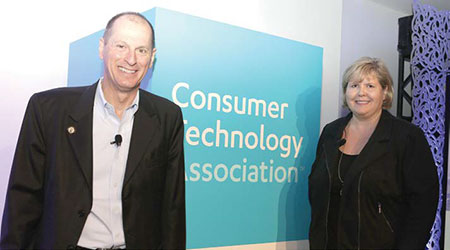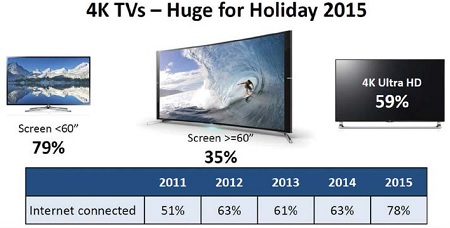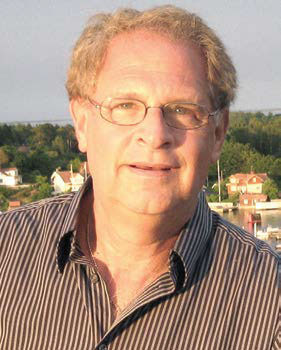Video Still Shines at CES
LAS VEGAS—Although the sponsors’ name has changed, one of the stars of CES 2016 promises to remain the same as it has in recent years: Video and the myriad devices used to view it. And although TV set sales are slowing down, optimistic forecasts persist for 4K ultra high-definition screens.

Consumer Technology Association President Gary Shapiro and Karen Chupka, senior vice president for CES and corporate business strategy for CTA unveiled the association’s name change from “Consumer Electronics Association” last month. The show will now be referred to as “CES.”
Demonstrations of the next-gen ATSC 3.0 broadcast technology will pop up on the show floor and in private suites, while the FCC chairman will explain his rush for the broadcast spectrum auction, which may affect 3.0’s market timing.
More than 450 exhibitors list “video” among their product lines at the 2016 show yet the traditional TV giants will focus on significantly different screens at the annual consumer electronics extravaganza. LG is expected to demonstrate a two-sided “rollable” screen, Panasonic will showcase its “value-priced” 4K/smart TV sets and Chinese TV makers will expand their big-screen line-up. Yet much of CES’ screen focus will be mobile and portable devices.
WHAT’S IN A NAME?
CES, which is expected to attract nearly 180,000 attendees during its Jan. 6 to 9 run at the Las Vegas Convention Center and surrounding environs, will be a conundrum filled with contradictions. This is the first major event since the sponsoring organization swapped “technology” for “electronics” as its middle name (now the Consumer Technology Association or CTA) in November and opted to label this event “CES” rather than the “International Consumer Electronics Show” of yore.
“World over, it is CES,” said CTA President and CEO Gary Shapiro about brand recognition of the show when the association announced its name change.
Although the CES centerpiece will be the products from nearly 3,700 exhibitors, the hundreds of ancillary conference sessions and the growing presence of the content industry (about 25,000 attendees) will inevitably shift the techno-economic impact of the event. Vast exhibits and presentations about wearables, automotive electronics, health and wellness technology will overwhelm the audio-video debuts, which were once CES’ highlight.
Get the TV Tech Newsletter
The professional video industry's #1 source for news, trends and product and tech information. Sign up below.
Video will still be highly visible, albeit often focused on streaming ventures.
“TV and content are really strong,”said Karen Chupka, senior vice president for CES and corporate business strategy for CTA. “We have at least 100 exhibitors showcasing 4K UHD TV,” plus new exhibits for 4-K Blu-ray and smart TVs.
“It’s an exciting time for screens because so many people are trying to figure out how to put their content on multiple screens,” she said. As a result, “content is really the big story” at CES, according to Chupka. Reflecting the focus on non-broadcast video, CES keynoters include Netflix co-founder and CEO Reed Hastings and YouTube’s Chief Business Officer Robert Kyncl. NBC Universal CEO Stephen Burke will keynote the “C Space” program, a fast-growing conference and exhibit program at CES’s newly added third major venue in Las Vegas. C Space is the CES experience for creative communicators, brand marketers, advertising agencies, digital publishers and social networks, CTA said.
Chupka also pointed out that Turner Broadcasting will do a live National Basketball Association program from the convention floor. TV ventures will punctuate the Las Vegas landscape, ranging from a Scripps Networks hospitality tent in front of the main convention center to an audition for “Shark Tank,” the Emmy Award-winning ABC hit show.
Among the broadcasters attending CES will be members of the Pearl TV consortium, according to Ann Schelle, managing director of the alliance of major broadcast groups that is exploring next-generation digital media platforms.
“Pearl TV members will be coming to Las Vegas to see the latest consumer technology innovations,” Schelle said, “not only in television but also in a variety of mobile devices and automobiles that will populate the show floor. We anticipate seeing ATSC 3.0 demonstrations, as well, to begin to educate CES attendees about the forthcoming move to advanced television and the advantages of better video, more choices, integration with the Internet, advanced emergency alerting, and other benefits.”
ATSC 3.0 will be on display in Samsung’s and other booths as well as in private demonstrations, according to several sources. (See “Sinclair Demos HDR 4KTV Over ATSC 3.0 in Vegas.”) The CES show floor will be dotted with other breakthrough devices, such as the rollable LG screen that uses organic light emitting diode, or OLED technology, to enable flexible, thin, light and double-sided screens. Since the expected demo is still a prototype, details of LG’s plan for a working television are not yet available.
POLICY AND INNOVATION
As CTA increasingly focuses on public policy issues that impact innovative technologies and security and privacy, CES is packing its agenda with industrial and regulatory giants. In addition to keynotes from the top executives of Intel, Samsung and General Motors, the agenda includes all of the commissioners from the Federal Communications Commission and the Federal Trade Commission, who will take the stage on opening day. FCC Chairman Tom Wheeler and FTC Chairwoman Edith Ramirez will each sit down with CTA’s Shapiro for a 30-minute “SuperSession” discussion. Later that day, all four other commissioners from each agency will participate in a two-part “Commissioner Roundtable” as part of the CES Innovation Policy conference track.
FCC Commissioners Mignon Clyburn, Jessica Rosenworcel, Ajit Pai, and Michael O’Rielly will begin by discussing allocating more licensed and unlicensed spectrum for mobile broadband, improving the accessibility of consumer technologies, increasing broadband adoption and speeds, fostering competition and innovative service offerings for consumers and other topics related to technological convergence and communications.
For the second part of the roundtable, FTC Commissioners Julie Brill, Maureen Ohlhausen, and Terrell McSweeny will address emerging policy issues surrounding the Internet of Things, balancing data privacy with consumer adoption of new services and potential upcoming regulatory reform. “This is a great opportunity for CES attendees to hear how the FCC and FTC’s top regulators view their agency’s role in enhancing competition, stimulating entrepreneurship and supporting the kind of disruptive innovation on display at CES,” Shapiro said.
Opening day will also include “Industry Innovators and Government Join Forces,” during which U.S. Chief Technology Officer Megan Smith and Deputy Director for Technology and Innovation Tom Kalil will lead a discussion with global industry trendsetters to examine entrepreneurship, “smart cities” and other issues.
TV’S ROLES
At a “CES Unveiled” preview in New York last month, which included holiday sales forecasts, CTA Chief Economist/Senior Research Director Shawn DuBravac explained that TV sets are slipping in the sales ranking of the Big 5 categories.
Consumers have “less interest in TVs,” DuBravac said, compared to smartphones and tablets, where total spending levels will be higher this season. He said that only 17 percent of consumers plan to buy a new TV set this year, compared to 24 percent during the 2014 holiday shopping season. CTA’s data show that 84 percent of U.S. households now have at least one LCD TV.
Among potential TV set buyers, Internet connectivity is a primary factor. Du-Bravac’s data showed that 78 percent of shoppers want a smart TV, up from 63 percent a year ago.

Despite the overall lackluster forecast for TV set sales, appetite for UHD sets continues to grow, with 59 percent of TV set shoppers in a new CTA survey saying they expect to buy a UHDTV for the holidays.
Despite the lackluster forecast, appetite for UHD sets continues to grow, with 59 percent of TV set shoppers in a new CTA survey saying they expect to buy a UHDTV for the holidays. This year’s expected sales of 4.5 million 4K TV sets is nearly triple the 2014 level, and DuBravac estimated that 8.9 million sets will be shipped in the U.S. in 2016 and just over 13 million in 2017. More significantly, shoppers have mixed views on how big their 4K sets should be. Nearly 80 percent want screens smaller than 60 diagonal inches (reflecting the price and available space), while 35 percent want screens larger than 60 inches, according to CTA’s study. (Since that sum is well over 100 percent, clearly some viewers want screens of all sizes.)
Adding to the UHD buzz will be announcements, such as one expected from DirecTV (now part of AT&T) that it will add more 4K programming to its line-up. The satellite TV provider has been testing UHD sportscasts for more than a year and recently said it has the capacity to carry 50 UHD channels at 30 Mbps in addition to its current HDTV and standard definition channels.
The UHD frenzy at CES comes amidst significant upbeat signals. For example, late last month, Samsung Electronics revealed that it sold more than $1 billion worth of TV sets in North America during October—a new monthly record. Samsung said that 4K UHDTV sets represented 51.2 percent of its third quarter 2015 U.S. sales.
TV manufacturers are also starting to specialize. For example, LG’s line-up includes two HDTV sets with built-in Roku capability, of which a “limited-time” version was made exclusively for sale at Best Buy stores during the holiday shopping season. Roku has introduced 4K-capable streaming players and has TV alliances with several other brands. LG has indicated that the Roku deal is solely for “entry-level” models and that it plans to use its own webOS platform for its core smart TV sets.
C SPACE, DIGITAL HOLLYWOOD AND RELATED TECH CONFERENCES
High dynamic range video, virtual reality and countless other TV technology issues are on the week’s agenda, which is jammed with more than 40 conference tracks plus seminars run by CTA and dozens of affiliated and independent groups. Mature sectors such as video and audio are not as prominent as they once were. Even the Institute of Electrical and Electronics Engineers at its annual International Conference on Consumer Electronics is devoting its entire agenda to consumer healthcare, fitness and personal diagnostics.
The Advanced Imaging Society will run three-session conference about high dynamic range, high frame rate, 4K and virtual reality on Thursday. The sessions are intended to identify “which technologies are in the driver’s seat,” according to event organizers. Presentations from 20th Century Fox, Netflix, Dreamworks and Dolby will examine technical standards as well as Hollywood’s HDR and VR playbook plus 2016 industry forecasts.
C Space, now in its third year, will focus on advertising, marketing and digital media. The agenda explores the relationship between brands, agencies, media and technology partners, with an emphasis on the shifting relationship of technology with innovation.
At the Variety Entertainment Summit, seven sessions will delve into OTT Entertainment, Content Monetization and Digital Audience Engagement. Speakers include executives from Disney/ABC Television Group, Fox Networks Group, Discovery Communications, Hulu and Sony Pictures Entertainment. A keynote conversation within the conference will feature TV host and producer Ryan Seacrest and iHeartRadio Chairman and CEO Bob Pittman.
The venerable Digital Hollywood features more than a dozen sessions this year, spread over three days. “The Future of TV: From Primetime to Multi-Platforms” will hear from NBCUniversal, Starz, Deloitte and other media/business executives. Other sessions will explore “Original Video Programming: Internet TV Goes Mainstream,” “Content and Monetization” and “The Disruption of Internet TV: Programming Everywhere.”

David Leibowitz, CH Potomac
David Leibowitz, managing partner of media and technology firm CH Potomac, will moderate the Internet TV session; he’s focused on the growing challenge of navigating programs across platforms.
“The growing array of over-the-top, ‘TV Everywhere,’ and ‘skinny bundle’ cable packages has made it more difficult for users to find what they want to watch across these offerings,” Leibowitz said. “While universal search is the ‘holy grail’ in solving this problem, competitive interests among the largest providers have complicated making universal search a reality.”
For the “Broadband at CES” conference on Tuesday, just before the show opens, organizer Team Lightbulb has included a session about “5G: Incremental Change or the Next Revolution.”
Despite the “stricter credentialing” (as Chupka calls the show’s attendee ceiling), CES’s attendance will probably be comparable to the 176,676 people who attended the 2015 show. About 30 percent of the attendees—nearly 48,000 people—will come from outside the U.S., Chupka said.
The show has already set a record as the largest show of its kind ever, occupying 2.3 million square feet of floor space in all venues. The start-up section at the Sands called “Eureka Park”—mostly small booths for new and early-stage companies—will have more than 500 exhibitors, about 25 percent more innovators than last time.
“Everyone is going to be blown away by the technology and by the opportunity for people to be looking at more things on more devices,” Chupka said.
To register for the 2016 CES, visit www.cesweb.org.
Also see...
December 21, 2015
“CES 2016 Implements New Security Measures”
Bag checks, body screening and increased security personnel added for conference.
Gary Arlen, a contributor to Broadcasting & Cable, NextTV and TV Tech, is known for his visionary insights into the convergence of media + telecom + content + technology. His perspectives on public/tech policy, marketing and audience measurement have added to the value of his research and analyses of emerging interactive and broadband services. Gary was founder/editor/publisher of Interactivity Report, TeleServices Report and other influential newsletters; he was the long-time “curmudgeon” columnist for Multichannel News as well as a regular contributor to AdMap, Washington Technology and Telecommunications Reports; Gary writes regularly about trends and media/marketing for the Consumer Technology Association's i3 magazine plus several blogs.

